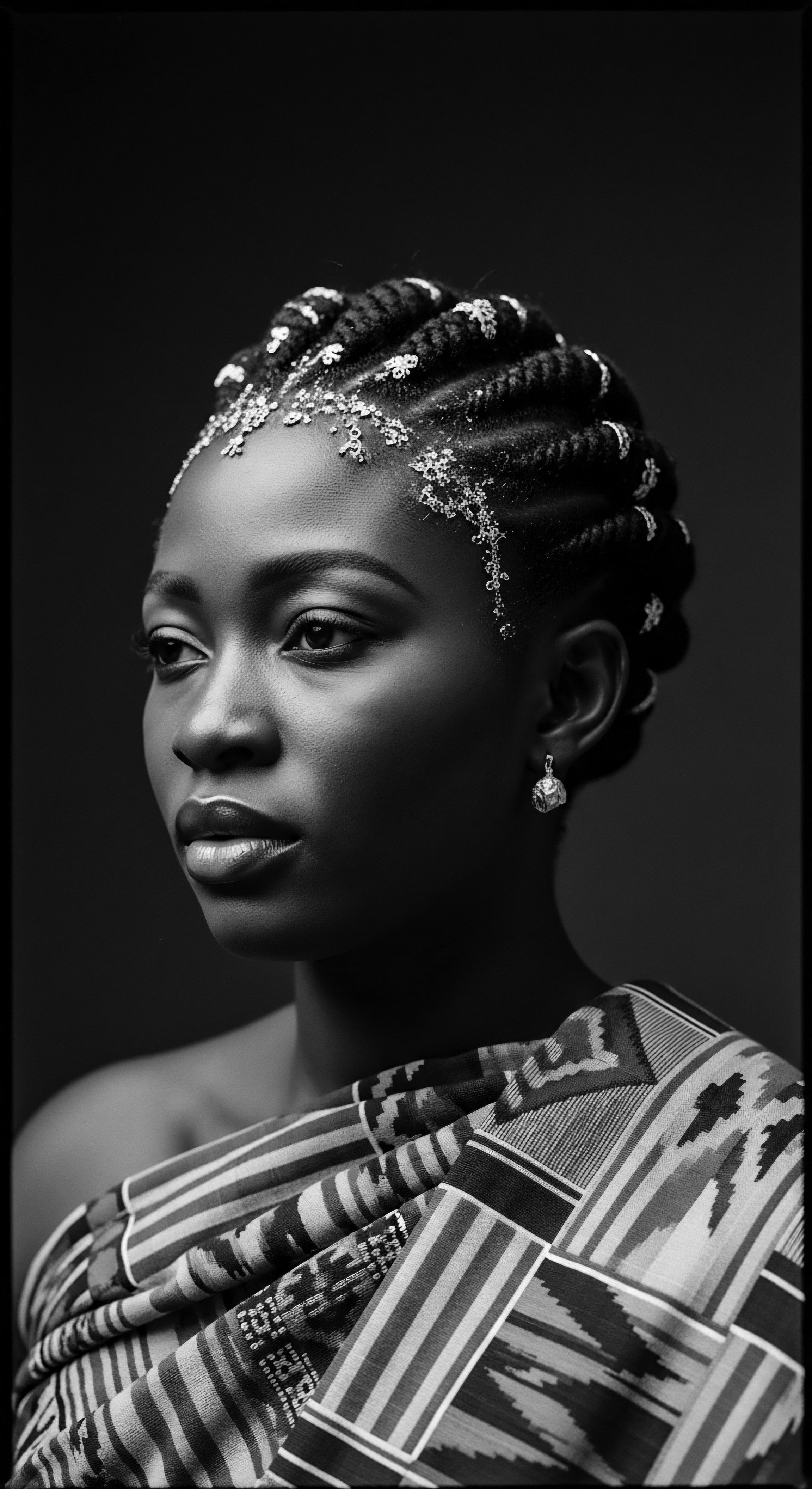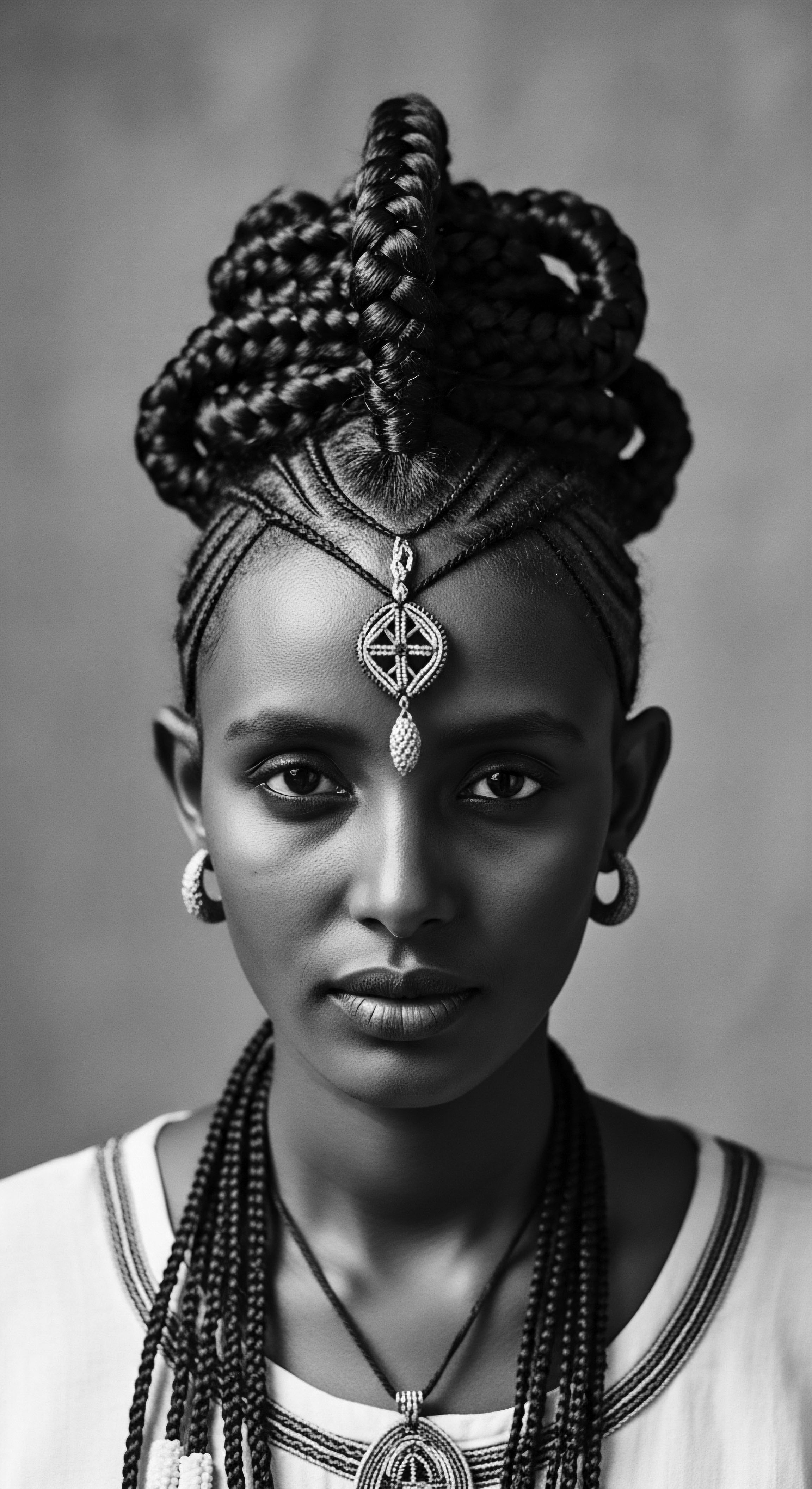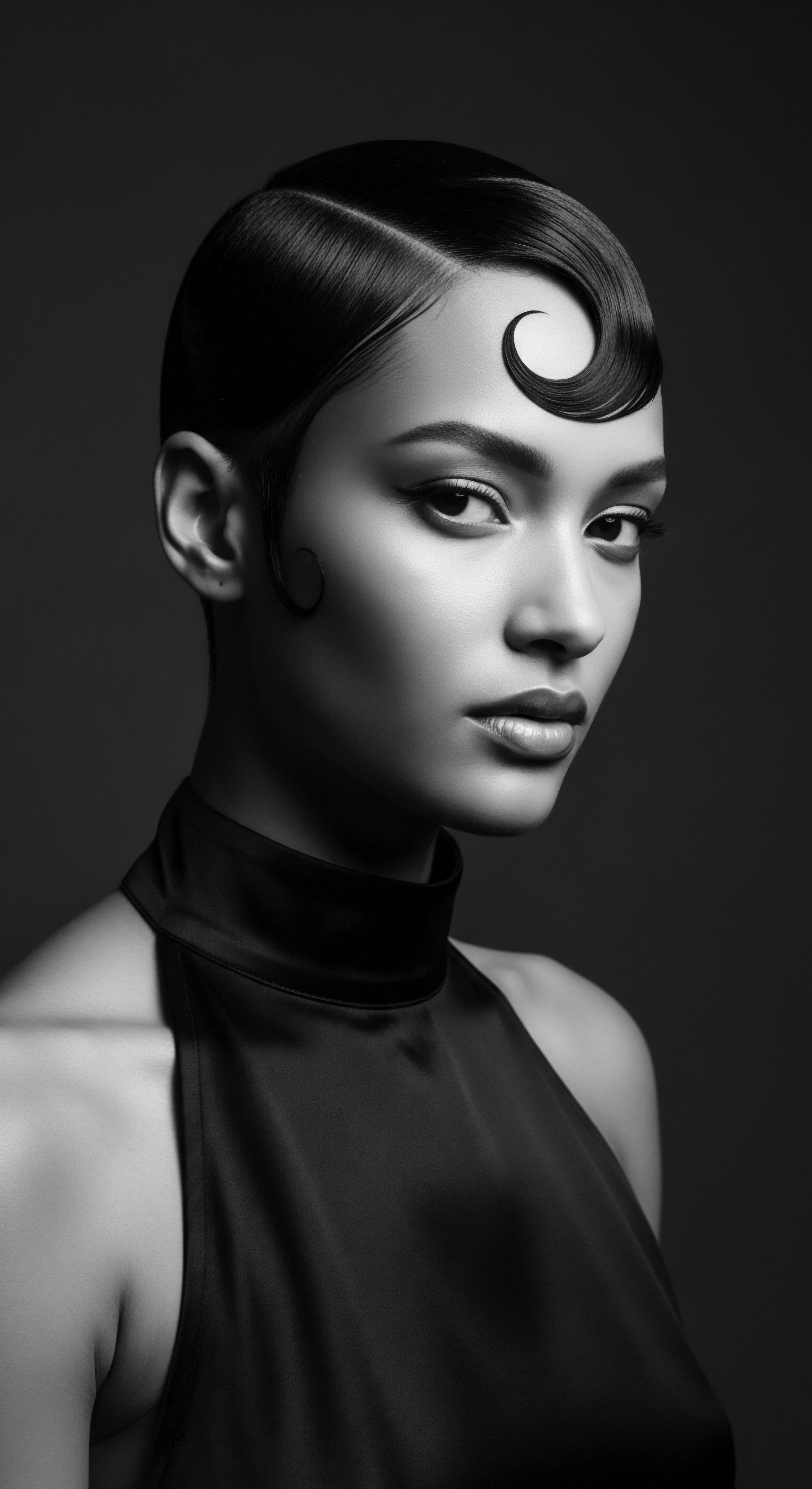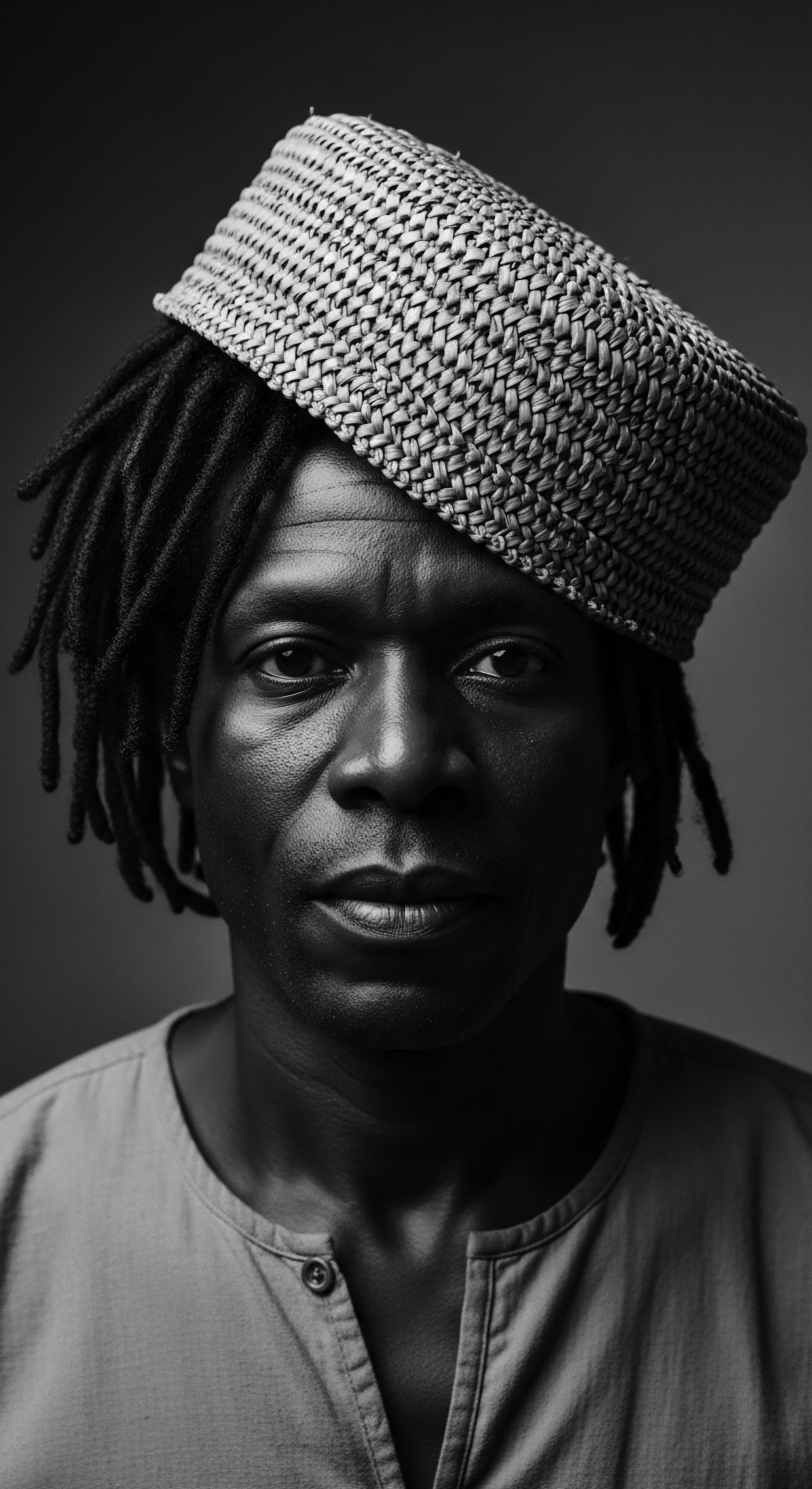
Roots
Our strands hold ancient whispers, a lineage traced not only through human hands but also through the very bedrock of the earth. To truly grasp the health and heritage of textured hair, we must peer beneath the surface, to the geological compositions that shaped environments and, in turn, ancestral practices. This journey begins at the source, exploring the elemental connections that underpin our understanding of hair, its structure, and the legacy of its care. It is a story told in minerals, water, and earth, written over millennia in the hair follicles of our foremothers and forefathers.
The soil beneath our feet, the water flowing from the springs, the very air we breathe—all carry signatures of their geological origins. These signatures, often overlooked in modern discourse, directly influenced the plants grown, the water consumed, and the minerals available for traditional beauty practices across Black and mixed-race communities. Consider the sheer diversity of climates and terrains from which textured hair heritage springs ❉ the arid Saharan expanses, the lush rainforests of the Congo, the fertile plains of the American South, and the Caribbean islands.
Each landscape, sculpted by its unique geology, presented distinct challenges and offered particular solutions for hair care. The earth provided, and our ancestors, with their keen observation and intuitive wisdom, responded.

Hair Anatomy and Its Ancestral Echoes
At its core, hair is a protein filament, primarily composed of Keratin. Yet, the specific shape and structure of a hair strand—what we perceive as its texture—is deeply tied to the follicle from which it springs. Textured hair, particularly afro-textured hair, is characterized by its high curvature, an elliptical cross-section, and a retro-curvature at the hair bulb, resulting in an asymmetrical S-shaped follicle.
These structural aspects lend themselves to unique properties, such as a higher density of Disulfide Bonds, which contribute to its distinctive shape and strength. (Hexis Lab)
The environment, too, plays a part in the external manifestation of hair’s inherent nature. From a scientific perspective, hair morphology can be influenced by environmental factors such as humidity and chemical exposures, alongside genetic predispositions. However, what interests us here, in the exploration of heritage, is how these environmental forces, themselves products of geological conditions, informed the ancestral understanding of hair.
For instance, the very air’s moisture content, influenced by regional geography and proximity to large bodies of water, dictates how textured hair might respond to its surroundings, influencing its dryness or its ability to retain curl. Ancient communities observed these phenomena, developing practices that worked with, rather than against, the hair’s natural inclinations, guided by the local climatic and geological realities.
The ground beneath us whispers secrets about the hair that grows from our scalps, a heritage imprinted by the earth’s ancient design.

Geological Footprints on Water and Scalp Health
One of the most direct impacts of geological composition on hair health comes through Water Quality. The “hardness” of water, determined by its mineral content, particularly calcium and magnesium, directly impacts how hair responds to washing. Hard water can cause a build-up of minerals on the hair shaft, leading to dryness, frizz, dullness, and even an itchy scalp. This build-up can block hair follicles, preventing natural oils from reaching the surface and potentially reducing hair growth.
(Hudson & Fouquet) Textured hair, already prone to dryness due to its structural characteristics, is particularly susceptible to the damaging effects of hard water. (WaterScience)
Across ancestral communities, there was an intuitive grasp of these environmental challenges. While scientific terms like “calcium carbonate” were absent from their lexicon, the effects of hard water on hair and skin were surely observed and addressed through trial and error over generations. This led to the development of specific washing and rinsing rituals.
- Rainwater Collection ❉ Many communities, particularly in regions with hard groundwater, relied on rainwater, a naturally soft water source, for washing hair and skin. This practice mitigated the harshness of mineral deposits.
- Acidic Rinses ❉ The use of fermented plant derivatives, like sour fruits, apple cider vinegar, or fermented rice water, might have served as natural chelating agents. These acidic rinses could help to dissolve mineral buildup, restoring balance to the hair and scalp.
- Herbal Infusions ❉ Certain plants, rich in natural acids or saponins, were infused in water to temper its mineral content or to provide a gentler cleansing experience. The wisdom of these botanicals was passed down through the generations, a quiet antidote to environmental challenges.

The Earth’s Bounty in Hair Care Traditions
The geological composition of a region dictates not only the water but also the soil, influencing the plants that thrive and the minerals available. Clays, rich in various minerals, have been employed for centuries in traditional African beauty and holistic health treatments. (Daily Maverick) These soft mineral substances, products of weathered volcanic ash, derive their unique compositions from the physical and chemical environmental factors to which they were exposed over time. (Daily Maverick)
For instance, the use of Ibomvu, a red ochre clay found in Southern Africa, dates back approximately 400,000–500,000 years. This pigmented iron oxide clay, varying in color from light yellow to deep reds, has been used by various Southern African peoples, including the Zulu, Xhosa, and Himba tribes, as a natural hair treatment mask, promoting cell regeneration and offering sun protection. (Daily Maverick) The Himba women of Namibia, for example, are known for coating their hair and bodies in a mixture of animal fat and red ochre clay, which provides protection from UV rays and acts as a mosquito repellent. (Daily Maverick) This practice powerfully links geological availability to ancestral hair care traditions, health, and a deep sense of cultural identity.
Beyond clays, the soil’s mineral content also influenced the nutrient density of edible crops and medicinal plants. (News-Medical) Ancestral communities, living intimately with the land, understood the reciprocal relationship between healthy soil, nourishing plants, and robust bodies, including hair. While scientific studies now reveal how soil micronutrients like zinc and iron impact human health and growth, our ancestors knew, through generations of observation, which plants to use for various ailments or for promoting physical well-being, including that of the hair and scalp. (News-Medical) This deep understanding of local flora, itself a product of geological context, is a fundamental aspect of textured hair heritage.

Ritual
The rhythmic application of balm, the intricate braiding of strands, the gathering of herbs under a specific moon—these are not mere acts of beautification. They are rituals, imbued with purpose and ancestral wisdom, shaped by the earth’s offerings. The geological composition of a land directly influenced the materials available for these ceremonies of care, making the connection between textured hair heritage and the earth profoundly tangible. This section explores how the earth’s bounty dictated the ancient techniques, tools, and transformations that define textured hair styling and care traditions.

Styling with Earth’s Own
Traditional styling, far from being a simple aesthetic choice, was often a protective measure, born from understanding how hair interacted with its local environment. The protective styles seen across the African diaspora—cornrows, twists, bantu knots, and various forms of braiding—have ancestral roots that stretch back millennia. (OkayAfrica) These styles were not only expressions of status, age, and identity but also practical responses to environmental conditions, many of which were shaped by geological factors. The mineral content of water, for instance, could dry out hair, making protective styles essential for moisture retention.
Consider the ingenuity of styling practices that used materials directly from the earth. Clays, as previously discussed, were not just for cleansing but also for coloring, sculpting, and conditioning. The deep reds and yellows of ochre clays, derived from iron oxides, were used for body and hair adornment, providing both aesthetic and protective benefits. (Daily Maverick) These practices underscore a truth ❉ the earth provided the palette and the medium for ancestral hair artistry.

Tools and Techniques from the Land
The tools used in traditional hair care and styling were often direct products of the earth. Smooth stones, carved wood, or bone implements served as combs, detanglers, or even styling aids. The properties of these materials—their density, smoothness, or ability to retain heat—were understood intuitively.
For example, combs made of wood or ivory were favored by ancient Egyptians for gentle detangling, reflecting a belief in careful handling to avoid damage. (Rthvi) This echoes a timeless understanding of hair’s fragility, especially textured hair with its inherent curves and bends.
The very act of collecting and preparing natural ingredients constituted a significant part of the ritual. Shea butter, a staple in West African communities, extracted from shea nuts, is a testament to the localized botanical resources influencing hair care. (Africa Imports) Its moisturizing and healing properties are highly valued, offering a natural shield against harsh environmental conditions. The geological underpinnings, influencing soil and climate, determined the distribution and health of the shea tree, making its butter a regional treasure.
Similarly, Argan Oil, native to Morocco, comes from the argan tree which thrives in specific semi-desert regions, its growth influenced by the unique geology of the Atlas Mountains foothills. (Orlando Pita Play) The oil’s rich fatty acid and vitamin E content became a cornerstone of Moroccan hair care, renowned for its moisturizing and frizz-reducing properties. (Orlando Pita Play)
Hair rituals, far from being superficial, are echoes of ancestral wisdom, shaped by the very ground that nurtured our forebears.

Water’s Influence on Styling and Hold
The water available for washing and styling also played a quiet yet consistent role. Hard water, rich in calcium and magnesium, makes it harder for hair to absorb moisture and can lead to dullness, frizz, and difficulty in styling. (Culligan) This environmental reality necessitated adaptive techniques. Traditional practices might have included:
- Rinsing Aids ❉ Beyond acidic rinses for cleansing, certain plant mucilages or natural gums, sourced from local botany (itself dependent on geology), might have been used to soften water or provide a slippery coating that counteracted mineral buildup, easing detangling and manipulation.
- Styling with Dampened Hair ❉ Many traditional styles rely on working with hair in a damp state, allowing its natural curl pattern to express itself before being locked into a protective style. This practice would have been particularly effective in mitigating the effects of hard water, as fresh, soft water (like rainwater or purified water) would be used for initial wetting, and then sealed in by styling.
- Moisturizing Post-Wash ❉ Heavy, natural oils and butters were often applied immediately after washing to seal in moisture, creating a barrier against the drying effects of hard water and environmental exposure. This ancient practice, documented in various African communities, counters the modern claim that raw oils and butters are always detrimental, suggesting that historical use was context-dependent. (Reddit)
The chemical composition of water, a direct outcome of geological factors, informed generations of nuanced choices in hair care, from selecting particular plants for rinses to establishing the frequency and method of washing. These choices, passed down through families and communities, are vital components of textured hair heritage.
| Traditional Ingredient Ibomvu Clay (Red Ochre) |
| Geological/Environmental Connection Iron oxide deposits in Southern African soils and geological formations. (Daily Maverick) |
| Traditional Ingredient Shea Butter |
| Geological/Environmental Connection Shea trees thriving in specific West African savanna regions with particular soil and climate conditions. (Africa Imports) |
| Traditional Ingredient Argan Oil |
| Geological/Environmental Connection Argan trees endemic to semi-desert areas of Morocco, influenced by the geology of the Atlas Mountains. (Orlando Pita Play) |
| Traditional Ingredient Local Water Quality |
| Geological/Environmental Connection Mineral content (calcium, magnesium) in regional groundwater, directly tied to underlying rock formations. (Culligan) |
| Traditional Ingredient The earth provides the very materials that define ancestral hair care, linking geological composition to daily routines. |
The creation of tools for hair care, from combs to vessels for mixing, was also a testament to human adaptability within geological constraints. A simple gourd for holding water, a smooth stone for grinding herbs, or a wooden comb carved from a local tree all represent how the immediate environment, shaped by deep earth processes, became integral to the daily life of hair care. These aren’t just artifacts; they are extensions of a living heritage, speaking to the resourcefulness and scientific observation embedded in our ancestors’ approach to hair.

Relay
The wisdom gathered through generations, born from intimate exchanges with the land, is a living archive, continuously passed down. This section traces the more profound cultural and contextual meanings of geological composition on textured hair heritage, moving beyond practical application to explore its impact on identity, community, and the ongoing dialogue between ancient knowledge and modern understanding. Here, the echoes of geological influence resonate in the very definition of who we are.

Geological Composition and Hair’s Cultural Markers
Hair, in many Black and mixed-race cultures, has always served as a canvas for identity, a powerful symbol of status, spirituality, and belonging. (ResearchGate) The styles, the adornments, and the care rituals often conveyed intricate social meanings, reflecting a group’s history, values, and relationship to their environment. Geological composition, by influencing the availability of specific materials, became an unwitting co-creator of these cultural markers.
The vibrant colors of ochre clays, for example, were not merely decorative; they were pigments sourced directly from the earth, carrying symbolic weight tied to fertility, protection, or rites of passage. (Sabinet African Journals)
Consider the Himba people of Namibia. Their distinctive practice of coating hair and body with Otjize, a mixture of butterfat, ochre pigment (Ibomvu), and aromatic resins, is a profound illustration of geological composition shaping cultural heritage. This red clay, derived from the iron-rich soils of their ancestral lands, is not just a cosmetic; it is a cultural marker, a shield against the sun and insects, and a symbol of life, earth, and spiritual connection. (Daily Maverick) The very redness of their skin and hair, a signature of their identity, is a direct outcome of the regional geology.
This practice, meticulously sustained across generations, speaks to an inherited understanding of local resources and their potent utility. As Matjila (2020) observes, hair in Southern Africa has, for many years, been a locus of social, physical, and emotional experience, with styles reflecting deep historical influences. The red clay, therefore, stands as a quiet defiance, a refusal to abandon ancestral ways in the face of pressures to conform to other beauty standards.
Beyond the Himba, numerous communities across Africa incorporated localized earth-derived ingredients into their daily and ceremonial hair practices. The Igbo women of Nigeria, for instance, used different clays like Nzu and Edo for body painting and hair dyeing, connecting beauty practices with spiritual acts and communal identity. (Sabinet African Journals) These traditions underscore how geological resources became deeply embedded in the collective identity and heritage of these groups, their hair becoming a living testament to their environment and their legacy.

The Interplay of Water, Hair, and Ancestral Resilience
The challenges posed by certain geological compositions, particularly hard water, forced communities to develop adaptive strategies that were then passed down as a crucial part of their heritage. The constant battle against mineral buildup on textured hair, which can lead to dryness, breakage, and scalp irritation, required ingenuity. (Living Proof) Ancestral responses to this included not only the use of rainwater and acidic rinses but also the conscious selection and integration of specific botanicals. Plants known for their softening, clarifying, or moisturizing properties would have been sought and cultivated, their efficacy understood through generations of observation and application.
This ecological dance between humanity and geology illustrates Ancestral Resilience. The persistence of healthy, vibrant textured hair despite environmental challenges speaks volumes about the depth of inherited knowledge. It suggests a scientific understanding—albeit unwritten and experiential—of pH balance, chelation, and hydration long before modern chemistry articulated these concepts. The very survival and flourishing of textured hair traditions in diverse geological settings represents a quiet triumph of adaptation and inherited wisdom.

Connecting Soil Health to Hair’s Biological Vitality
The link between geological composition, soil health, and human well-being extends to hair’s biological vitality. Soil, rich in minerals, directly impacts the nutrient density of plants. (Domaine de Graux) These nutrient-dense plants, consumed as food or used in topical applications, would have provided essential minerals and vitamins crucial for hair growth and strength. In regions with mineral-deficient soils, ancestral diets or specific herbal remedies would have been developed to compensate, demonstrating an inherent knowledge of nutritional needs that extended to hair health.
For instance, soil zinc and iron content can impact human nutritional status, and agronomic fortification in certain areas of the world is used to increase crop mineral concentration. (News-Medical) This highlights a broader connection ❉ the health of the earth’s crust directly contributes to the building blocks of our hair.
Our hair carries the ancestral story of the earth, its minerals, and the resilient wisdom of those who lived upon it.
The quality of plant protein, whether consumed or applied topically, also influences hair strength and hydration. (Curlvana) Plants thriving in mineral-rich soils would naturally yield more potent ingredients for hair care. The relationship is cyclical ❉ healthy geology yields healthy soil, which yields healthy plants, which supports healthy hair.
This understanding formed the bedrock of ancestral wellness philosophies, viewing the body and its manifestations, including hair, as intrinsically linked to the surrounding natural world. The relay of this profound connection is what defines textured hair heritage today.
A powerful historical example of this geological link to hair health and heritage comes from the practices of communities that have long inhabited regions with distinct water characteristics. For instance, the traditional uses of certain plant-based ingredients in areas known for hard water. While formal studies on specific geological effects on ancient hair are limited, ethnographic accounts and historical records provide glimpses. In certain West African communities, where geological formations lead to mineral-rich, hard water sources, the reliance on particular botanical rinses and hair cleansing practices stands as a testament to adaptive heritage.
An analysis by Kalu (1999) and Ukwu (2000) on Igbo traditional practices, for example, notes the use of earth-derived ingredients for beautification and even for hair dyeing, which would have naturally interacted with local water properties. (Sabinet African Journals) This highlights a subtle, yet enduring connection, where the earth’s composition dictated a continuous process of ingenuity and adaptation, shaping hair traditions over centuries.
The knowledge of how to treat and style hair in specific environmental conditions was not merely technical; it was a deeply ingrained cultural transmission. The methods used to prepare cleansing agents from local plants, to condition hair with regionally available oils, or to protect it from harsh sun and mineral-laden water all became part of a collective memory, a shared inheritance. This is the relay of heritage—where the environment, sculpted by geological forces, becomes an active participant in shaping a people’s identity and their enduring relationship with their hair.

Reflection
To consider how geological composition touches the health and heritage of textured hair is to engage in a profound meditation on interconnectedness. It is to step back from the modern world’s swift solutions and listen to the enduring wisdom held within each strand, each curl, each coil—a wisdom that echoes from the very earth beneath our feet. This exploration has been a journey through time and terrain, revealing that our textured hair is not merely a biological feature; it is a living archive, a repository of ancestral knowledge, environmental adaptation, and cultural resilience.
The geological landscape, with its mineral-rich waters and diverse soils, its sun-drenched plains and humid forests, provided the crucible in which the heritage of textured hair care was forged. Our ancestors, acutely attuned to their surroundings, observed the effects of hard water, the benefits of local clays, and the potency of native botanicals. They then ingeniously crafted practices, rituals, and tools that honored and protected their hair, ensuring its vitality across generations. This was not abstract science; it was lived science, passed down through the gentle braiding of a mother’s hands, the shared laughter in communal hair sessions, and the stories told around evening fires.
This deep connection to the earth’s composition offers us a potent reminder today. It encourages us to look beyond fleeting trends and reconsider the very source of our ingredients, the quality of the water we use, and the wisdom embedded in localized, traditional practices. When we understand that the very minerals in our water or the soil that nourished ancestral plant ingredients have a bearing on hair health, we begin to approach care with a reverence that transcends mere cosmetic concern. It becomes an act of honoring heritage, a recognition of the enduring legacy of those who walked before us, drawing sustenance and solutions directly from the earth.
Roothea’s ‘Soul of a Strand’ ethos finds its deepest resonance here, in the understanding that textured hair carries the memory of landscapes, the wisdom of ancestral adaptation, and the unbroken spirit of a people. Our hair, truly, is a living, breathing archive of our journey, intimately bound to the geological story of our collective past. It is a testament to beauty, resilience, and the power of earth-rooted heritage, a story still being written with every generation.

References
- Kalu, K. (1999). Gender and the State in Nigeria ❉ A Study of Politics, Culture and Beauty. Lawrenceville, NJ ❉ Africa World Press.
- Ukwu, O. (2000). Hair in African Art and Culture. New York ❉ Museum for African Art.
- Matjila, C. R. (2020). The Meaning of Hair for Southern African Black Women. University of the Free State.
- Sieber, R. & Herreman, F. (2000). African Dressing and Adornment. Harry N. Abrams.
- Byrd, A. D. & Tharps, L. D. (2001). Hair Story ❉ Untangling the Roots of Black Hair in America. St. Martin’s Press.
- Bernolles, J. (1966). Les coiffures de femmes africaines. Paris ❉ Éditions Saint-Paul.
- Carretero, M. I. (2002). Clay minerals and their beneficial effects upon human health. Applied Clay Science, 21(3-4), 155-163.
- Carretero, M. I. & Pozo, M. (2009). Clay Minerals in Cosmetics. Applied Clay Science, 43(1-2), 1-13.
